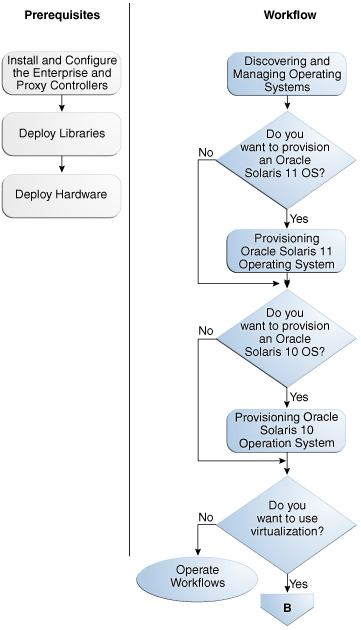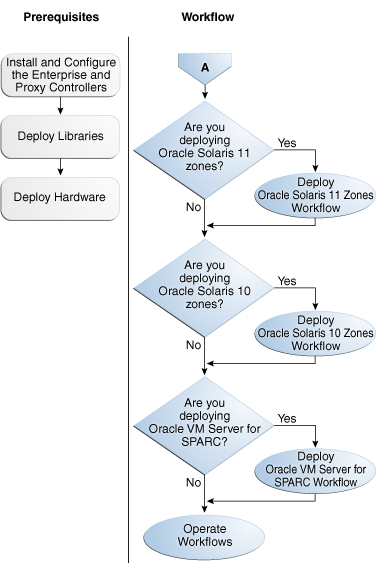| Oracle® Enterprise Manager Ops Center Deploy Operating Systems Workflow 12c Release 1 (12.1.2.0.0) Part Number E37253-01 |
|
| PDF · Mobi · ePub |
| Oracle® Enterprise Manager Ops Center Deploy Operating Systems Workflow 12c Release 1 (12.1.2.0.0) Part Number E37253-01 |
|
| PDF · Mobi · ePub |
Deploy Operating Systems Workflow
12c Release 1 (12.1.2.0.0)
E37253-01
November 2012
This workflow provides an end-to-end example for how to use Oracle Enterprise Manager Ops Center.
Workflows are divided into two categories: Deploy and Operate. Each workflow is a compilation of several examples.
This workflow is an example of how to use Oracle Enterprise Manager Ops Center to deploy an operating system (OS). The examples in this workflow include how to discover and manage existing operating systems and how to deploy new operating systems. Deploying new operating systems describes how to provision, or upgrade, an Oracle Solaris 11 and Oracle Solaris 10 OS that is running on managed systems or how to deploy an Oracle Solaris OS on unconfigured (bare metal) systems. Separate workflows describe how to deploy Oracle Solaris Zones or logical domains on Oracle VM Server for SPARC.
Two options are available for managing operating systems: agent-managed and agentless-managed. An agent-managed operating system has an Agent Controller installed to gather information for the Enterprise Controller and is required for some OS-specific features, such as OS provisioning, creating zones, updating some OS versions, and some of analytics and reporting features. To demonstrate the capabilities, these workflows and examples use an agent-managed operating system. You can learn more about agent and agentlessly-managed assets in the Oracle Enterprise Manager Ops Center Feature Reference Guide.
Note:
If you will use the software to provision or update Oracle Solaris 11 operating systems, the Enterprise Controller and a Proxy Controller must be installed on an Oracle Solaris 11 operating system. This is required to utilize the library, update, and provisioning functionality.Provisioning an operating system requires that the Proxy Controller is in the same subnet as the systems to be provisioned.
The following permissions and roles are required to complete the tasks in the workflow:
Asset Admin or Ops Center Admin
Discover operating systems and choose a management style, agent managed or agentlessly managed. For agent managed, deploy the Agent Controller on the operating system.
Plan/Profile Admin
Create and manage the discovery profiles
Security Admin
Create credentials
Figure 1 and Figure 2 are the workflows for deploying operating systems in your data center. Each diagram lists the prerequisite workflows on the left and the tasks and decisions for the workflow on the right.
In Figure 1, the workflow includes discovering and managing existing operating systems, provisioning an Oracle Solaris operating system to upgrade to a new release, or provisioning Oracle Solaris 10 or 11 operating system on a brand new, bare metal system that does not yet contain an operating system.
Figure 2 is a workflow for deploy operating systems in a virtualized environment. These include Oracle Zones and logical domains with Oracle VM Server for SPARC.
Before you begin, ensure that you have met the following prerequisites that are listed in the workflow.
Oracle Enterprise Manager Ops Center installed and configured.
Install the Enterprise Controller and a Proxy Controller on Oracle Solaris 11 if you plan on provisioning or updating Oracle Solaris 11 operating systems.
Deploy Libraries.
The storage infrastructure that you will use for provisioning and updating operating systems, provisioning and updating firmware, and storage for virtualization operations.
Deploy hardware.
The servers and storage devices in your data center are discovered and visible in the user interface.
Figure 1 Deploy Workflow for Operating Systems – Part A

Figure 2 is a continuation of the Deploy Workflow for Operating Systems. Use this workflow if you plan on deploying Oracle Solaris Zones or logical domains for Oracle VM Server for SPARC.
Figure 2 Deploy Operating Systems Workflow – Part B

At the end of this workflow, you will have operating systems that you can monitor, provision, and update with Oracle Enterprise Manager Ops Center.
To deploy operating system or hardware virtualization, see the following workflows:
To begin monitoring and managing your operating systems with Oracle Enterprise Manager Ops Center, see the Operate workflows in the How To library.
The Oracle Enterprise Manager Ops Center 12c documentation is located at http://www.oracle.com/pls/topic/lookup?ctx=oc121. See the following:
The Oracle Enterprise Manager Ops Center Feature Reference Guide has information about asset management, storage, networks, zones, and Oracle VM Server for SPARC.
The Oracle Enterprise Manager Ops Center Administration Guide has information about user roles and permissions.
For more examples, see the How To library.
For in-depth information about zones, see the Oracle Solaris Zones documentation at http://docs.oracle.com/cd/E23824_01/html/821-1460/index.html.
For in-depth information about Oracle Solaris 11, see the Oracle Solaris 11 documentation at http://docs.oracle.com/cd/E23824_01/html/821-1460/index.html.
For information about Oracle's commitment to accessibility, visit the Oracle Accessibility Program website at http://www.oracle.com/pls/topic/lookup?ctx=acc&id=docacc.
Oracle customers have access to electronic support through My Oracle Support. For information, visit http://www.oracle.com/pls/topic/lookup?ctx=acc&id=info or visit http://www.oracle.com/pls/topic/lookup?ctx=acc&id=trs if you are hearing impaired.
Oracle Enterprise Manager Ops Center Deploy Operating Systems Workflow , 12c Release 1 (12.1.2.0.0)
E37253-01
Copyright © 2007, 2012, Oracle and/or its affiliates. All rights reserved.
This software and related documentation are provided under a license agreement containing restrictions on use and disclosure and are protected by intellectual property laws. Except as expressly permitted in your license agreement or allowed by law, you may not use, copy, reproduce, translate, broadcast, modify, license, transmit, distribute, exhibit, perform, publish, or display any part, in any form, or by any means. Reverse engineering, disassembly, or decompilation of this software, unless required by law for interoperability, is prohibited.
The information contained herein is subject to change without notice and is not warranted to be error-free. If you find any errors, please report them to us in writing.
If this is software or related documentation that is delivered to the U.S. Government or anyone licensing it on behalf of the U.S. Government, the following notice is applicable:
U.S. GOVERNMENT END USERS: Oracle programs, including any operating system, integrated software, any programs installed on the hardware, and/or documentation, delivered to U.S. Government end users are "commercial computer software" pursuant to the applicable Federal Acquisition Regulation and agency-specific supplemental regulations. As such, use, duplication, disclosure, modification, and adaptation of the programs, including any operating system, integrated software, any programs installed on the hardware, and/or documentation, shall be subject to license terms and license restrictions applicable to the programs. No other rights are granted to the U.S. Government.
This software or hardware is developed for general use in a variety of information management applications. It is not developed or intended for use in any inherently dangerous applications, including applications that may create a risk of personal injury. If you use this software or hardware in dangerous applications, then you shall be responsible to take all appropriate fail-safe, backup, redundancy, and other measures to ensure its safe use. Oracle Corporation and its affiliates disclaim any liability for any damages caused by use of this software or hardware in dangerous applications.
Oracle and Java are registered trademarks of Oracle and/or its affiliates. Other names may be trademarks of their respective owners.
Intel and Intel Xeon are trademarks or registered trademarks of Intel Corporation. All SPARC trademarks are used under license and are trademarks or registered trademarks of SPARC International, Inc. AMD, Opteron, the AMD logo, and the AMD Opteron logo are trademarks or registered trademarks of Advanced Micro Devices. UNIX is a registered trademark of The Open Group.
This software or hardware and documentation may provide access to or information on content, products, and services from third parties. Oracle Corporation and its affiliates are not responsible for and expressly disclaim all warranties of any kind with respect to third-party content, products, and services. Oracle Corporation and its affiliates will not be responsible for any loss, costs, or damages incurred due to your access to or use of third-party content, products, or services.